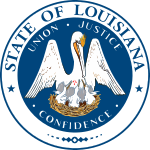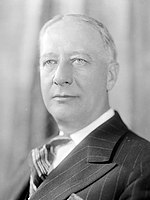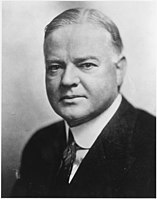| ||||||||||||||||||||||||||
| ||||||||||||||||||||||||||
 Parish Results
Smith 50-60% 60-70% 70-80% 80-90% 90-100%
| ||||||||||||||||||||||||||
| ||||||||||||||||||||||||||
| Elections in Louisiana |
|---|
 |
|
|
The 1928 United States presidential election in Louisiana took place on November 6, 1928, as part of the wider United States presidential election. Voters chose ten representatives, or electors, to the Electoral College, who voted for president and vice president.
Ever since the passage of a new constitution in 1898, Louisiana had been a one-party state dominated by the Democratic Party. The Republican Party became moribund due to the disenfranchisement of Black voters and the complete absence of other support bases, as Louisiana lacked upland or German refugee whites opposed to secession.[1] Despite this single-party dominance, non-partisan tendencies remained strong among wealthy sugar planters in Acadiana and within the business elite of New Orleans.[2]
Following disfranchisement, the state’s politics became dominated by a coalition of the New Orleans-based Choctaw Club of Louisiana and Black Belt planters.[3] Opposition began to emerge with the Socialist Party in the lumbering parishes of the northern hills and Imperial Calcasieu in the late 1900s, and more seriously with the Progressive movement, chiefly in the southern sugar-growing parishes, in the 1910s. Conflicts with President Wilson’s Underwoood-Simmons Act[4] allowed Progressive Whitmell P. Martin[a] to be elected to the Third Congressional District in 1914, and in 1920 the racially less hardline[5] Acadiana region turned to Republican candidate Warren G. Harding[6] over disagreements on foreign policy and the Nineteenth Amendment.[7] Continued opposition to the Choctaw Club would elect former Progressive John M. Parker as governor at the beginning of 1920; however, Parker did not deliver his promised reforms, and Choctaw control returned temporarily with the 1924 election of Henry L. Fuqua.[8]
Louisiana’s delegates to the Democratic National Convention largely backed Catholic New York Governor Al Smith, who was opposed in the remainder of the South for his religion and opposition to Prohibition.[9] At the same time, the state Republican Party — like those of Mississippi and South Carolina, entirely a vehicle for Federal patronage — was undergoing a "lily white" takeover by Walter Cohen’s black-and-tan faction, although blacks were not expelled from the party as occurred in Alabama, North Carolina, and Virginia.[10]
Unlike in the Upper South, Louisiana Democrats were controlled by fears that theRepublican nominee, former Secretary of Commerce Herbert Hoover, supported racial equality.[9] Although in the Protestant north and Florida Parishes there was opposition to Smith’s religion and views on Prohibition, this was overshadowed by the desire for loyalty to the one-party system as an instrument of white supremacy,[11] a viewpoint supported by newly-elected Governor Huey Long.[9] Moreover, identification with Smith’s Catholicism was strong in Acadiana, where commitment to white supremacy was less intense.[12]
Consequently Smith and Arkansas Senator Joseph T. Robinson won Louisiana with 76.29 percent of the popular vote, to 23.70 percent for Hoover and Senate Majority Leader Charles Curtis of Kansas. Only in two parishes — Livingston and Washington, both proximate to the deeply anti-Catholic Mississippi Pine Belt and Florida panhandle — did Hoover pass forty percent of the vote, while in many Acadian parishes Hoover underperformed Calvin Coolidge by over thirty points. Louisiana was Smith's third strongest state in the election, after South Carolina and neighboring Mississippi.[13]
- ^ Phillips, Kevin P. The Emerging Republican Majority. pp. 208, 210. ISBN 9780691163246.
- ^ Schott, Matthew J. (Summer 1979). "Progressives against Democracy: Electoral Reform in Louisiana, 1894-1921". Louisiana History: The Journal of the Louisiana Historical Association. 20 (3): 247–260.
- ^ Wall, Bennett H.; Rodriguez, John C. Louisiana: A History. pp. 274–275. ISBN 1118619293.
- ^ Collin, Richard H. (Winter 1971). "Theodore Roosevelt's Visit to New Orleans and the Progressive Campaign of 1914". Louisiana History: The Journal of the Louisiana Historical Association. 12 (1): 5–19.
- ^ Howard, Perry H. (1954). "A New Look at Reconstruction". Political Tendencies in Louisiana, 1812-1952; An Ecological Analysis of Voting Behavior (Thesis). LSU Historical Dissertations and Theses. pp. 112–113. OCLC 8115.
- ^ Phillips. The Emerging Republican Majority, p. 268
- ^ Wall and Rodriguez. Louisiana: A History, p. 277
- ^ Sindler, Allan P. (1956). Huey Long's Louisiana: State Politics, 1920-1952. Baltimore: Johns Hopkins University Press. pp. 40–41.
- ^ a b c Wingo, Barbara C. (Autumn 1977). "The 1928 Presidential Election in Louisiana". Louisiana History: The Journal of the Louisiana Historical Association. 18 (4). Louisiana Historical Association: 405–435.
- ^ Fairclough, Adam (2008). Race and Democracy: The Civil Rights Struggle in Louisiana, 1915-1972. Athens, Georgia: University of Georgia Press. p. 11. ISBN 0820331147.
- ^ Phillips. The Emerging Republican Majority', p. 212
- ^ Phillips. The Emerging Republican Majority, pp. 214, 268-269
- ^ "1928 Presidential Election Statistics". Dave Leip’s U.S. Election Atlas.
Cite error: There are <ref group=lower-alpha> tags or {{efn}} templates on this page, but the references will not show without a {{reflist|group=lower-alpha}} template or {{notelist}} template (see the help page).
© MMXXIII Rich X Search. We shall prevail. All rights reserved. Rich X Search


